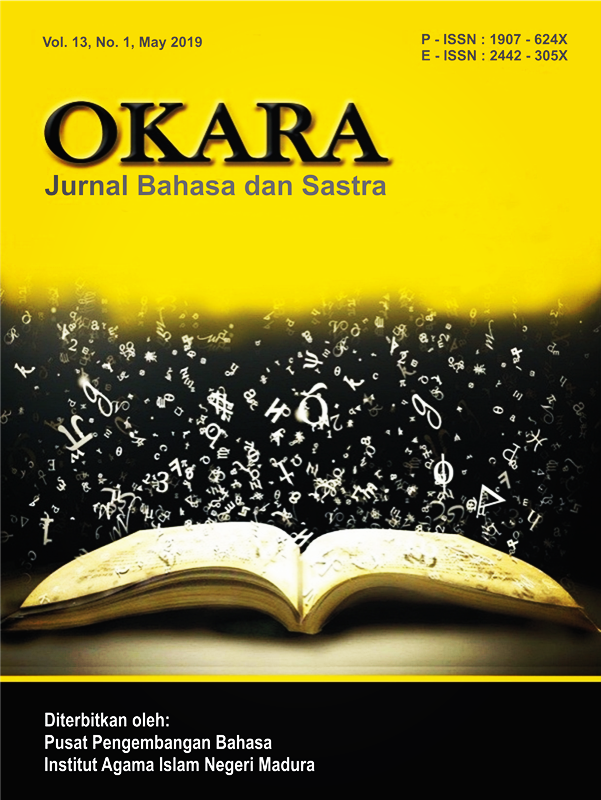Portraying Learner’s Autonomy in Extensive Reading Classroom
 Abstract views: 668
,
Abstract views: 668
,
 PDF downloads: 427
PDF downloads: 427
Abstract
Extensive reading, the activities to read a large amount of text and enjoyable input, becomes important to study since it has so many benefits for increasing the students’ language competence. It has been noticed that this kind of activity really engages the students because it allows them to receive a large amount of comprehension in a leisure way. In this activity, they may also choose any reading sources and materials that are extremely enjoyable, and suitable with their level and interest promoting their learning autonomy which are responsible for their own learning. Thus this study has the purpose to portray the characteristics of their autonomous learning while joining extensive reading classroom. In this study, blog as instructional technology is used as a learning platform for supporting them conduct extensive reading activities. To collect the data, interview was given to six students who become participants of the study. It aimed to deeply investigate their autonomous learning while doing extensive reading. The findings show that there are several characteristics of autonomous learning in this class. They are setting the goal of their learning, adjusting learning strategies to improve learning, knowing how to use resources autonomously, managing the time properly, and having motivation to learn independently.
Downloads
References
Alyousef, Hesham Suleiman. “Teaching Reading Comprehension to ESL/EFL Learners.” The Reading Matrix 5, no. 2 (September 2005): 12.
Aydin, Selami. “The Use of Blogs in Learning English as a Foreign Language.” Mevlana International Journal of Education 4, no. 1 (March 1, 2014): 244–59. https://doi.org/10.13054/mije.13.79.4.1.
Bell. “Extensive Reading: Speed and Comprehension.” The Reading Matrix Vol 1 No 1 April 2001 1, no. 1 (October 28, 2018). http://www.readingmatrix.com/articles/bell/.
Benson. Teaching and Researching Autonomy in Language Learning. Harlow: Longman Pearson Education, 2001.
Braun, V., & Clarke, V. "Using thematic analysis in psychology. Qualitative research in psychology", 3(2), (2006): 77-101
Brown, Dale. “Online Support Systems for Extensive Reading: Managing the Tension between Autonomy and Institutional Education.” The Language Teacher: JALTCALL Journal 36, no. 2 (2012): 11–16.
Chew, Magdalene Meow, and Catherine Cheng Kiat Lee. “Using a Blog to Facilitate Extensive Reading: An Exploratory Study.” IAFOR Journal of Education 1, no. 1 (May 2013): 160–64. https://doi.org/10.22492/ije.1.1.06.
Ciel Language Support Network. “Integrating Independent Learning with the Curriculum | LLAS Centre for Languages, Linguistics and Area Studies.” Accessed March 18, 2018. https://www.llas.ac.uk//resources/gpg/1400.
Enciso, Olga Lucía Uribe. “Estrategias de Aprendizaje: Reflexiones Sobre El Término.” Matices En Lenguas Extranjeras 0, no. 4 (April 14, 2013). https://revistas.unal.edu.co/index.php/male/article/view/30138/33607.
Fatimah, Asri Siti, and Santiana Santiana. “Teaching in 21st Century: Students-Teachers’ Perceptions of Technology Use in the Classroom.” Script Journal: Journal of Linguistic and English Teaching 2, no. 2 (October 8, 2017): 125. https://doi.org/10.24903/sj.v2i2.132.
Fattah, Said Fathy El Said Abdul. “The Effectiveness of Using Blogs as an Independent Learning Tool to Develop Reading Skills for University Students.” Journal of Education and Practice 7, no. 32 (2016): 65–73.
Haddad, Rawan Hamdi. “Developing Learner Autonomy in Vocabulary Learning in Classroom: How and Why Can It Be Fostered?” Procedia - Social and Behavioral Sciences 232 (October 2016): 784–91. https://doi.org/10.1016/j.sbspro.2016.10.106.
Lyutaya, Tatiana. “Reading Logs: Integrating Extensive Reading with Writing Tasks.” English Teaching Forum 14, no. 1 (2011): 26–34.
McCombs, Barbara L. “Unraveling Motivation: New Perspectives From Research and Practice.” The Journal of Experimental Education 60, no. 1 (September 1991): 3–3. https://doi.org/10.1080/00220973.1991.10806575.
Mede, Enisa, Gorsev Incecay, and Volkan Incecay. “Fostering Learner Autonomy through Extensive Reading: The Case of Oral Book Reports.” International Association of Research in Foreign Language Education and Applied Linguistics: ELT Research Journal 2, no. 1 (2013): 16–25.
Meigen, Yu. “On the Cultivation of Non-English Majors’Learner Autonomy.” International Journal of Education and Research 4, no. 10 (October 10, 2016). http://www.ijern.com/journal/2016/October-2016/10.pdf.
Murray, Garold, Xuesong Gao, and Terry Lamb, eds. Identity, Motivation and Autonomy in Language Learning. Second Language Acquisition 54. Bristol ; Buffalo: Multilingual Matters, 2011.
Neupane, Madhu. “Learner Autonomy: Concept and Considerations.” Journal of NELTA 15, no. 1–2 (January 1, 1970): 114–20. https://doi.org/10.3126/nelta.v15i1-2.4617.
Penggabean, Christina I.T. and Ingelia Kesuma. “Language Learning Strategies Of High Proficiency Students in Their Oral Presentation at English Language Education of PGRI Ronggolawe University Tuban. OKARA: Jurnal Bahasa dan Sastra, vol. 11, no. 2, November 2017 (November, 2017) : 206. http: // doi.org/ 10.19105/ojbs .v11i2.1501
Pinkman, Kathleen. “Using Blogs in the Foreign Language Classroom: Encouraging Learner Independence.” The JALT CALL Journal 1, no. 1 (2005): 12–24.
Prensky, Marc. “Digital Natives, Digital Immigrants.” Horizon 9, no. 5 (March 2, 2018): 15–24.
Stoeckel, Tim, Nevitt Reagan, and Fergus Hann. “Extensive Reading Quizzes and Reading Attitudes.” TESOL Quarterly 46, no. 1 (March 2012): 187–98. https://doi.org/10.1002/tesq.10.
Takahashi, Wataru, and Tae Umino. “Out-of-Class Extensive Reading in Japanese as A Second Language: Enhancing Learner Autonomy Beyond the Classroom.” In Proceedings of CLasic, 2018. https://www.fas.nus.edu.sg/cls/CLaSIC/clasic2016/PROCEEDINGS/takahashi_wataru.pdf.
Ushioda, Ema. Learner Autonomy 5: The Role of Motivation. Dublin: Authentik, 1996.
The journal operates an Open Access policy under a Creative Commons Attribution-NonCommercial 4.0 International License. Authors who publish with this journal agree to the following terms:
- Authors retain copyright and grant the journal right of first publication with the work simultaneously licensed under a Creative Commons Attribution License that allows others to share the work with an acknowledgement of the work's authorship and initial publication in this journal.
- Authors are able to enter into separate, additional contractual arrangements for the non-exclusive distribution of the journal's published version of the work (e.g., post it to an institutional repository or publish it in a book), with an acknowledgement of its initial publication in this journal.
- Authors are permitted and encouraged to post their work online (e.g., in institutional repositories or on their website) prior to and during the submission process, as it can lead to productive exchanges, as well as earlier and greater citation of published work.





_(1).png)
.png)
.png)
1.png)
.png)
.png)

.png)
_-_Copy_-_Copy.png)





